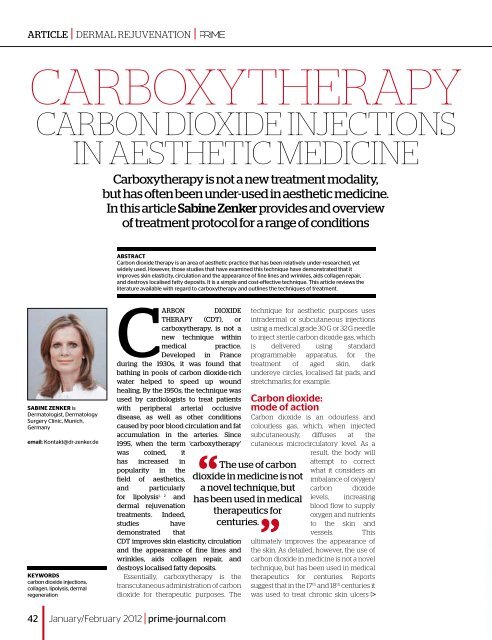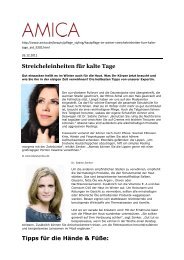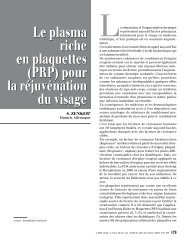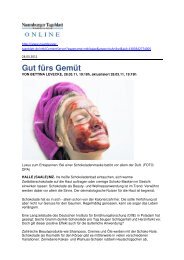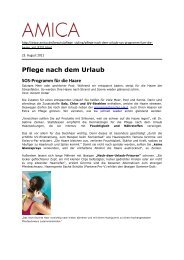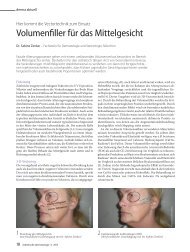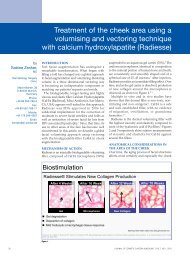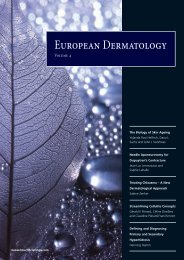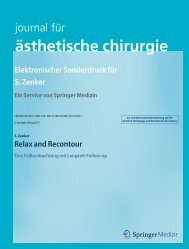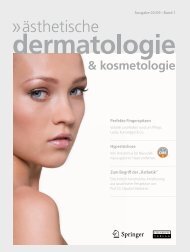Carboxytherapy - Dr. Zenker Dermatologie
Carboxytherapy - Dr. Zenker Dermatologie
Carboxytherapy - Dr. Zenker Dermatologie
You also want an ePaper? Increase the reach of your titles
YUMPU automatically turns print PDFs into web optimized ePapers that Google loves.
artICLe | dERmAl REjuvEnATion |<br />
<strong>Carboxytherapy</strong><br />
Carbon DioxiDe injeCtions<br />
in aesthetiC MeDiCine<br />
<strong>Carboxytherapy</strong> is not a new treatment modality,<br />
but has often been under-used in aesthetic medicine.<br />
In this article Sabine <strong>Zenker</strong> provides and overview<br />
of treatment protocol for a range of conditions<br />
Sabine <strong>Zenker</strong> is<br />
Dermatologist, Dermatology<br />
Surgery Clinic, Munich,<br />
Germany<br />
email: Kontakt@dr-zenker.de<br />
keywordS<br />
carbon dioxide injections,<br />
collagen, lipolysis, dermal<br />
regeneration<br />
abSTraCT<br />
Carbon dioxide therapy is an area of aesthetic practice that has been relatively under-researched, yet<br />
widely used. However, those studies that have examined this technique have demonstrated that it<br />
improves skin elasticity, circulation and the appearance of fine lines and wrinkles, aids collagen repair,<br />
and destroys localised fatty deposits. It is a simple and cost-effective technique. This article reviews the<br />
literature available with regard to carboxytherapy and outlines the techniques of treatment.<br />
Carbon dIoxIde<br />
therapy (Cdt), or<br />
carboxytherapy, is not a<br />
new technique within<br />
medical practice.<br />
developed in France<br />
during the 1930s, it was found that<br />
bathing in pools of carbon dioxide-rich<br />
water helped to speed up wound<br />
healing. by the 1950s, the technique was<br />
used by cardiologists to treat patients<br />
with peripheral arterial occlusive<br />
disease, as well as other conditions<br />
caused by poor blood circulation and fat<br />
accumulation in the arteries. Since<br />
1995, when the term ‘carboxytherapy’<br />
was coined, it<br />
has increased in<br />
popularity in the<br />
field of aesthetics,<br />
and particularly<br />
for lipolysis 1, 2 and<br />
dermal rejuvenation<br />
treatments . . Indeed,<br />
studies have<br />
demonstrated that<br />
Cdt improves skin elasticity, circulation<br />
and the appearance of fine lines and<br />
wrinkles, aids collagen repair, and<br />
destroys localised fatty deposits.<br />
Essentially, carboxytherapy is the<br />
transcutaneous administration of carbon<br />
dioxide for therapeutic purposes. The<br />
42 January/February 2012 | prime-journal.com<br />
technique for aesthetic purposes uses<br />
intradermal or subcutaneous injections<br />
using a medical grade 30 G or 32 G needle<br />
to inject sterile carbon dioxide gas, which<br />
is delivered using standard<br />
programmable apparatus, for the<br />
treatment of aged skin, dark<br />
undereye circles, localised fat pads, and<br />
stretchmarks, for example.<br />
Carbon dioxide:<br />
mode of action<br />
Carbon dioxide is an odourless and<br />
colourless gas, which, when injected<br />
subcutaneously, diffuses at the<br />
cutaneous microcirculatory level. As a<br />
result, the body will<br />
attempt to correct<br />
what it considers an<br />
imbalance of oxygen/<br />
carbon dioxide<br />
levels, increasing<br />
blood flow to supply<br />
oxygen and nutrients<br />
to the skin and<br />
vessels. This<br />
ultimately improves the appearance of<br />
the skin. As detailed, however, the use of<br />
carbon dioxide in medicine is not a novel<br />
technique, but has been used in medical<br />
therapeutics for centuries. Reports<br />
suggest that in the 17th and 18th the use of carbon<br />
centuries it<br />
was used to treat chronic skin ulcers<br />
dioxide in medicine is not<br />
a novel technique, but<br />
has been used in medical<br />
therapeutics for<br />
centuries.
| dERmAl REjuvEnATion | artICLe
% saturation of haemoglobin with oxygen<br />
100<br />
80<br />
60<br />
40<br />
20<br />
Without<br />
CO 2 in the<br />
blood<br />
0 0 5 10 15<br />
Partial pressure of oxygen/kPa<br />
and for its anti-infective properties, and interest was<br />
reignited during the 1930s to treat organic and functional<br />
arteriopathies 4 . The term ‘carboxytherapy’ to describe<br />
the treatment was introduced over 60 years later, in<br />
1995, by luigi Parassoni during the Xvi national meeting<br />
of Esthetical medicine in Rome 5 . These days, the use of<br />
carboxytherapy, particularly in aesthetic and anti-ageing<br />
medicine, is now a lot more prevalent and increasing in<br />
popularity, particularly throughout Europe. A range of<br />
different devices are available with which to administer<br />
treatment, but essentially the physician will need a<br />
device which meets CE and iSo standards, and has<br />
filters to avoid contamination, allows for flow regulation,<br />
has a pressure regulator, and administers heated gas in<br />
order to reduce pain.<br />
in carboxytherapy, carbon dioxide is introduced to the<br />
patient’s skin. An excess of carbon dioxide in the injected<br />
tissue (hypercapnia) provides the stimulus in the oxygen<br />
requirement hypothesis 6 . Approximately 70% of carbon<br />
dioxide in the body reacts with plasmatic water to form<br />
carbonic acid:<br />
CO 2 + H 2 O = H 2 CO 3<br />
And ultimately reacting to leave bicarbonate dissolved<br />
in the blood plasma:<br />
H + - + HCO3 With CO 2 in<br />
the blood<br />
Figure 1 The Bohr’s<br />
effect. Oxygen levels in<br />
the tissue increase<br />
oxygenisation (adapted<br />
from Albergati et al 7 )<br />
Figure 2 The effects of<br />
carbon dioxide (NB.<br />
there are far more<br />
modes of action than<br />
those mentioned here)<br />
Figure 3 Technique when<br />
treating the periorbital<br />
area — typical injection points<br />
| dERmAl REjuvEnATion | artICLe<br />
Vasodilation for<br />
increased<br />
microcirculation<br />
Acidosis<br />
Release of growth<br />
factors for<br />
angiogenesis<br />
These reactions cause the pH of the blood to decrease<br />
and a release of oxygen to bodily tissue, increasing<br />
capillary blood flow. This, in turn, promotes Bohr’s effect<br />
(the oxyhaemoglobin dissociation curve) (Figure 1),<br />
which explains how readily haemoglobin acquires and<br />
releases oxygen molecules into the fluid that surrounds<br />
it. An increased concentration in carbon dioxide leads to<br />
a lower binding affinity of oxygen and haemoglobin 7 .<br />
Furthermore, the release of growth factors takes places,<br />
such as local angiogenic growth factors (Figure 2), which<br />
induce circulation, encourage lipolysis, and encourage<br />
dermal regeneration, for example.<br />
Increased circulation<br />
The overriding point to consider pertaining to increased<br />
circulation in carboxytherapy is that hypercapnia<br />
improves tissue oxygenation 8 . When applied topically<br />
(e.g. as Co 2 water bathing), the increase in carbon dioxide<br />
concentration within the tissue and peripheral blood<br />
vessels causes precapillary arterioles to dilate, ultimately<br />
increasing blood flow to the skin 9 . Hypercapnia further<br />
lowers the resistance of the arteries in the skin and<br />
muscles, which dilate on account of the decline in pH.<br />
This takes place even with carbon dioxide administration<br />
into the skin 10 . Curri and Bombardelli 11 reported the<br />
verification of this increased vasodilation in the<br />
arterioles and metarterioles, as well as the increased<br />
vasomotion, using optic video capillaroscopy. The<br />
prime-journal.com | January/February 2012 45
artICLe | dERmAl REjuvEnATion |<br />
Figure 4 Skin appearance during and after treatment of the periorbital area: (A) within 2 minutes; (B) 4 minutes; and (c) 6 minutes<br />
evidence, therefore, shows that carboxytherapy acts<br />
on the microcirculation at the level of the metarterioles,<br />
arterioles and precapillary sphincters, by increasing<br />
tissue flow velocity and improving lymphatic drainage<br />
as a result.<br />
one area in which carboxytherapy is used for<br />
circulation is in water bathing for arteriopathy, providing<br />
vasodilation and neovasodilation at the microvascular<br />
level 12 . one study showed that vasodilation is mediated<br />
by nitric oxide, which induces neoangiogenesis in vitro 13 ,<br />
while another showed that collateral blood flow in<br />
ischaemic hindlimb was enhanced via the mobilisation<br />
of endothelial progenitor cells 12 . When using transdermal<br />
carbon dioxide application to treat diabetic foot ulcers,<br />
Wollina et al found an improvement in granulation and a<br />
reduction in discharge after 1 week of treatment 14 .<br />
However, the authors did note that further prospective<br />
trials were necessary. in another study 1 , which examined<br />
the use of intradermal and subcutaneous<br />
carboxytherapy for the treatment of localised fat pads<br />
and cellulitis, the authors noted two significant<br />
microcirculatory changes after the administration of the<br />
therapy: an increased perfusion as measured using laser<br />
doppler flowmetry, and an increase in oxygen tension<br />
(Bohr effect on the oxygen dissociation curve).<br />
Lipolysis<br />
Brandi et al 1 showed that carboxytherapy positively<br />
affects the physiological oxidative lipolytic process:<br />
‘The data regarding measurements of the maximum<br />
circumference of the thigh, knee and abdomen taken<br />
before and at the end of the treatment showed a significant<br />
reduction in all patients.’<br />
Again, the treatment was found to be highly effective<br />
when administered subcutaneously for localised fat<br />
pads/cellulitis. during such treatment, it has been noted<br />
that the adipose tissue fractures, lysis of adipocytes<br />
occurs, and triglycerides are released into the<br />
intracellular spaces; none of the vascular structures<br />
are adversely affected during this treatment. A similar<br />
study found a significant reduction in the mean<br />
46 January/February 2012 | prime-journal.com<br />
the data regarding measurements of the<br />
maximum circumference of the thigh, knee and<br />
abdomen taken before and at the end of the treatment<br />
showed a significant reduction in all patients.<br />
Figure 5 Under-eye puffiness. (A) Before treatment and (B) 2 months after the first<br />
treatment (four treatments were performed in total). (C) Before treatment and (D) 3<br />
months after three treatments. (E) Before treatment and (F) 1 month after four treatments
artICLe | dERmAl REjuvEnATion |<br />
Figure 6 Subcutaneous injections to the submental area<br />
Figure 8 Clinical results of skin<br />
rejuvenation, before (A) and<br />
after (B) 10 treatment sessions<br />
48 January/February 2012 | prime-journal.com<br />
Figure 7 Treatment of localised<br />
fat pads — before (A) and after<br />
(B) three treatment sessions<br />
(using RioBlush)<br />
upper, mid and lower abdomen circumference in<br />
three different age groups who had been treated with<br />
carbon dioxide therapy, as well as significant weight loss<br />
and a reduced thigh circumference 15 . no serious<br />
complications were reported, and the author<br />
concluded that carboxytherapy is both safe and<br />
effective. These results align with those originally<br />
reported by Brandi 1 , and demonstrate that this treatment<br />
modality is both safe and effective. <strong>Carboxytherapy</strong><br />
has also shown to be effective when administered<br />
postoperatively, after liposuction for example.<br />
jose leon-Solarte, in a presentation at the 2007<br />
American Academy of Cosmetic Surgery, detailed<br />
that out of a total of 40 patients treated over a 6-week<br />
period, 34 (85%) had a dramatic improvement in<br />
cutaneous flaccidity, and the remainder (15%) had<br />
partial results.<br />
Dermal regeneration<br />
intradermal carboxytherapy for the treatment of ageing<br />
or damaged skin was developed from an animal-based<br />
blind, interventional, cross-sectional study, which<br />
injected carbon dioxide into the dermis of wistar rats 3 .<br />
The control group received injections of saline. The<br />
researchers in the study observed the compacting of<br />
collagen fibres following the infiltration of carbon<br />
dioxide, and especially when this took place<br />
intradermally. Furthermore, there was a notably<br />
improved appearance in the skin, as well as intense<br />
collagen turnover. The use of CdT on damaged or<br />
ageing skin also results in a thicker appearance of the<br />
dermis, the collagen fibres being distributed more<br />
diffusely 1 , and stimulates collagen synthesis 3 . This<br />
means that carboxytherapy can also be used to improve<br />
scar tissue through the increase in collagen deposition<br />
and reorganisation, and the improvement in skin<br />
texture and tone 16 .<br />
<strong>Carboxytherapy</strong> for aesthetics<br />
it is not surprising therefore, that carboxytherapy is now<br />
used as an aesthetic treatment to improve skin laxity<br />
and the overall appearance. The therapy can be used to<br />
treat ageing skin on the face and décolletage, dark<br />
undereye circles, stretch marks, cellulite, and localised<br />
fat pads. However, as with any medical treatment, there
are contraindications that the physician should take<br />
into account:<br />
■ Acute, untreated cardiovascular disease, uncontrolled<br />
blood pressure, and vasovagal episodes<br />
■ Acute respiratory problems<br />
■ Bleeding syndromes, cerebrovascular accident<br />
(stroke), acute thrombosis or recent pulmonary<br />
embolism<br />
■ Connective tissue disease<br />
■ Skin infection<br />
■ uncontrolled diabetes<br />
■ Pregnancy and lactation (although no data is available<br />
in this regard).<br />
it is also important to note that with carboxytherapy<br />
there is an absence of toxicity and any other relevant<br />
side-effects.<br />
Injection techniques and treatment<br />
protocols<br />
depending on the type of treatment to be performed,<br />
the injection technique will vary. intradermal injections<br />
should be used for dermal rejuvenation, while<br />
subcutaneous injections are reserved for lipolytic<br />
effects. When injecting for skin rejuvenation, the<br />
injection is performed<br />
intradermally using a 30 G<br />
needle. The injection angle<br />
should be maintained at < 150<br />
with bevel border up.<br />
immediately after injection,<br />
the Co 2 gas diffuses into the<br />
needle-surrounding tissue.<br />
The clinical endpoint of each<br />
injection is at the occurrence<br />
of an erythema and distension<br />
of the injected tissue. The flow<br />
of the Co 2 gas has to be<br />
adjusted individually. For<br />
Carbon dioxide<br />
therapy can be used<br />
to rejuvenate the skin on<br />
the face, décolletage, neck<br />
and hands, and improves<br />
rhytides, withered skin,<br />
fine wrinkling,<br />
lost tissue luminosity and<br />
skin laxity.<br />
subcutaneous injections, the injection will be into the<br />
subcutaneous structures; the injection angle should be<br />
30–450, using a 30 G needle. The same clinical endpoints<br />
will determine each injection. The gas should be cold for<br />
fat pad treatment, as it seems to be more effective<br />
(although the author was unable to find any evidence in<br />
the literature to support this).<br />
Periorbital area<br />
When used in the periorbital area, carboxytherapy can<br />
treat rhytides, dark circles, vascular pooling, tissue<br />
luminosity, skin laxity, and mild fatty prolapse. dark<br />
circles and wrinkles should be treated with intradermal<br />
injections, while mild fat pads should have a mix of<br />
intradermal and subcutaneous injections. Flow should<br />
be up to 40–60 cc/min, with warm gas and using a 30 G<br />
needle. Generally, patients will receive four to eight<br />
sessions, with one session every 2–4 weeks. The<br />
technique and typical injection points are shown in<br />
Figure 3. injections are usually painless, so anaesthesia is<br />
rarely used, but the patient will feel a warm sensation on<br />
injection (vasodilation). Between 5 and 10 minutes<br />
Figure 9 Skin rejuvenation on<br />
the neck, before (A) and after<br />
(B) eight treatment sessions<br />
(using RioBlush)<br />
| dERmAl REjuvEnATion | artICLe<br />
following injection, an erythema will occur around the<br />
treated area and the upper eyelid will inflate (Figures 4<br />
and 5). However, no post-treatment care is necessary,<br />
and the appearance of the eyes after the prescribed<br />
number of sessions is greatly improved (Figure 5).<br />
Facial fat pads<br />
To treat mild under-eye fatpads, a mixture of<br />
subcutaneous and intradermal injections should be<br />
used. Subcutaneous injections alone should be used for<br />
mental fat pads. indications for the use of carboxytherapy<br />
in the submental area include skin laxity, prejowl sulcus,<br />
an undefined jawline, and a mild fat pad under the chin.<br />
Techniques and results are shown in Figures 6–8.<br />
Dermal rejuvenation<br />
<strong>Carboxytherapy</strong> can be used to rejuvenate the skin on<br />
the face, décolletage, neck and hands, and improves<br />
rhytides, withered skin, fine wrinkling, lost tissue<br />
luminosity and skin laxity. using a 30 G needle, flow<br />
should be up to 80 cc/min, with intradermal injections<br />
spaced out by 1–2 cm. Patients will generally receive<br />
between four and eight treatment sessions every<br />
3–4 weeks. Clinical results are shown in Figure 9.<br />
prime-journal.com | January/February 2012 49
artICLe | dERmAl REjuvEnATion |<br />
Stretch marks<br />
When treating stretch marks with carboxytherapy,<br />
it is better to perform the technique on old, white<br />
depressed marks rather than young, red stretch marks.<br />
Also, deep striae are better than thin striae.<br />
Contraindications for this treatment<br />
protocol are infection, pregnancy<br />
and anti-coagulation. Treatment<br />
should combine intradermal and<br />
subcutaneous injections using<br />
warm gas and a 30 G needle. The<br />
flow should be up to 80–150 cc/min.<br />
more often than not,<br />
the patient will not necessarily<br />
experience any pain with this<br />
treatment as the stretchmarks<br />
already represent ruptured tissue;<br />
this means that the gas can diffuse more easily and is<br />
therefore less painful. Results are usually seen between<br />
four and 10 sessions, and should be maintained with<br />
two to three sessions per year. After injection, patients<br />
may experience the popcorn effect, erythema and a<br />
warm sensation, but clinical results are excellent<br />
(Figure 10). it is necessary to explain the typical popcorn<br />
effect: this shows up only in the treatment of<br />
stretchmarks and relates to the fact that the ruptured<br />
tissue of the stretchmarks allows the gas diffuse far<br />
more easily, with the Co 2 ‘popping’ the skin up. This<br />
References<br />
1. Brandi C, D’Aniello C, Grimaldi L et al.<br />
Carbon dioxide therapy in the treatment of<br />
localized adiposities: clinical study and<br />
histopathological correlations. Aesthetic Plast<br />
Surg 2001; 25(3): 170–4<br />
2. Campos V, Bloch L, Cordeiro T.<br />
<strong>Carboxytherapy</strong> for gynoid lipodystrophy<br />
treatment: the Brazilian experience. J Am<br />
Acad Dermatol 2007; 56: AB196<br />
3. Ferreira JC, Haddad A, Tavares SA.<br />
Increase in collagen turnover induced by<br />
intradermal injection of carbon dioxide in<br />
rats. J <strong>Dr</strong>ugs Dermatol 2008, 7(3): 201–6<br />
4. Duchêne-Marullaz P, Talvard J. Influence<br />
d’injections sous-cutanées de gaz thermal de<br />
Royat sur la teneur en anhyride carbonique<br />
du sang veineux efferent. Therapie 1986; 21:<br />
143–6<br />
Carbon<br />
dioxide therapy<br />
is a simple and<br />
cost-effective<br />
technique<br />
with minimal<br />
side-effects.<br />
5. Bartoletti CA, Parassoni L, Varlaro V. La<br />
carbossiterapia: una metodic in evoluzione.<br />
Rivista La Medicina Estetica. 1997; 2<br />
6. Varlaro V, Manzo G, Mugnaini F et al.<br />
<strong>Carboxytherapy</strong>: effects on microcirculation<br />
and its use in the treatment of severe<br />
lymphedema. A review. Acta Phleobologica<br />
2007; 8(2): 79–91<br />
7. Albergati F, Parassoni L, Lattarulo P,<br />
Varlaro V, Curris SB. Carbossiterapia e<br />
vasomotion: comparazione tra immagini<br />
video-capillaroscopiche e referti doppler<br />
laser flow dopo somminiatrazione di anidride<br />
carbonica. Rivista La Medicina Estetica. 1997<br />
8. Akça O, Doufas AG, Morioka N, Iscoe S,<br />
Fisher J, Sessler DI. Hypercapnia improves<br />
tissue oxygenation. Anaesthesiology 2002;<br />
97(4): 801–6<br />
50 January/February 2012 | prime-journal.com<br />
effect will fade after approximately 10 minutes, although<br />
an erythema sometimes remains for a little while longer.<br />
Conclusions<br />
<strong>Carboxytherapy</strong> refers to the cutaneous and subcutaneous<br />
administration of carbon dioxide gas for<br />
therapeutic purposes. By injecting small amounts<br />
of carbon dioxide gas into dermal and subdermal<br />
structures (such as fat), the body is triggered to<br />
increase the oxygen flow to the area injected, and<br />
consecutively increases collagen neogenesis as<br />
well as lipolysis. Therefore, the most common<br />
indications for CdT are skin flaccidity,<br />
sun-damaged skin, dark under-eye circles,<br />
localised fat pads, stretch marks, and cellulite. its<br />
ease of use, cost-effectiveness and safety makes<br />
CdT a successful treatment in aesthetic medicine.<br />
To further prove the efficacy of carboxytherapy, however,<br />
further clinical trials are necessary.<br />
� Declaration of interest None<br />
� Figure images 3, 4, 9 © RioBlush; 8 © RioBlush/<strong>Dr</strong> Cyril<br />
Blum; 10 © RioBlush/<strong>Dr</strong> Bernard Mole; 5, 6 © Sabine<br />
<strong>Zenker</strong><br />
9. Ito T, Moore JI, Koss MC. Topical<br />
application of CO2 increases skin blood flow. J<br />
Invest Dermatol 1989; 93(2): 259–62<br />
10. Diji A, Greenfield AD. The local effect of<br />
carbon dioxide on human blood vessels. Am<br />
Heart J 1960; 60: 907–14<br />
11. Curri SB, Bombardelli E. Local<br />
lipodystrophy and districtual<br />
microcirculation: proposed etiology and<br />
therapeutic management. Cosmet Toilet<br />
1994; 109: 51<br />
12. Irie H, Tatsumi T, Takamiya M et al. Carbon<br />
dioxide-rich water bathing enhances<br />
collateral blood flow in ischemic hindlimb via<br />
mobilization of endothelial progenitor cells<br />
and activation of NO-cGMP system.<br />
Circulation 2005; 111(12): 1523–9<br />
13. Murohara T, Horowitz JR, Silver M et al.<br />
Figure 10 Clinical results when<br />
treating stretch marks on dark/<br />
pigmented skin; (A) before<br />
treatment and (B) after eight<br />
sessions<br />
Key points<br />
■ <strong>Carboxytherapy</strong><br />
refers to the cutaneous<br />
and subcutaneous<br />
administration of<br />
carbon dioxide gas for<br />
therapeutic purposes<br />
■ The most common<br />
indications for<br />
carboxytherapy are skin<br />
flaccidity, sun-damaged<br />
skin, dark under-eye<br />
circles, localised fat<br />
pads, stretch marks,<br />
and cellulite<br />
■ Studies have<br />
demonstrated that<br />
carboxytherapy<br />
improves skin elasticity,<br />
circulation and the<br />
appearance of fine lines<br />
and wrinkles, aids<br />
collagen repair, and<br />
destroys localised fatty<br />
deposits<br />
Vascular endothelial growth factor/vascular<br />
permeability factor enhances vascular<br />
permeability via nitric oxide and prostacyclin.<br />
Circulation 1998; 97(1): 99–107<br />
14. Wollina U, Heinig B, Uhlemann C.<br />
Transdermal CO2 application in chronic<br />
wounds. Int J Low Extrem Wounds 2004; 3(2):<br />
103–6<br />
15. Lee GS. Carbon dioxide therapy in the<br />
treatment of cellulite: an audit of clinical<br />
practice. Aesthet Plast Surg 2010; 34(2):<br />
239–43<br />
16. Nach R, Zandifar H, Gupta R, Hamilton JS.<br />
Subcutaneous carboxytherapy injection for<br />
aesthetic improvement of scars. Ear Nose<br />
Throat J 2010; 89(2): 64–6


